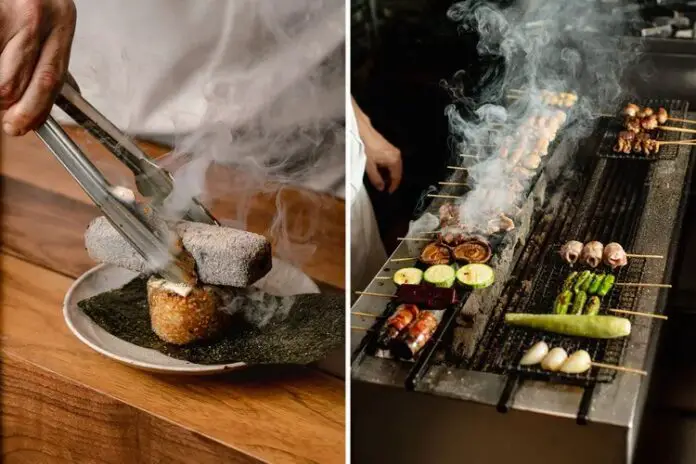Asian cuisine is thriving in Mexico City, and you can experience this exciting trend at these popular spots.
Mexico City is renowned for its diverse culinary scene, featuring beloved dishes from across the country, such as Oaxacan moles and Yucatán’s cochinita pibil. However, many visitors might not realize that the capital’s food culture is also significantly influenced by international flavors, especially from Asia.
With one of Latin America’s largest populations of Japanese and Korean heritage, Mexico City has a rich history of East Asian immigrants who first arrived in the late 1800s as industrial workers. Today, their culinary traditions are being creatively fused with Mexican ingredients by a new generation of chefs, both native and immigrant.
Edo Kobayashi, originally from Ensenada on Mexico’s Pacific coast, opened Hikoyo nearly a decade ago in the Cuauhtémoc neighborhood, close to the Japanese embassy. “I saw the opportunity to introduce yakitori, and later sushi and ramen,” Kobayashi explains. Alongside traditional Japanese dishes, diners can enjoy locally inspired items like grilled avocado, baby corn, and jalapeños. Kobayashi has since launched over 20 restaurants nationwide, drawing inspiration from the culinary heritage of the first Japanese immigrants to Mexico, particularly those in Chiapas and Sinaloa.
Korean cuisine is also making its mark. Dooriban, founded by five Korean and Mexican women who initially sold their homemade kimchi, opened in 2021 in Roma Norte. It offers hearty dishes like bibimbap and kimchi fried rice, seasoned with gochugaru, a Korean paste made from Mexican guajillo chiles. “Mexican and Korean cuisines may differ, but they share many similarities, such as the use of heat, fermentation, and traditional beverages,” says cofounder Sofia Acuña. Recently, Acuña and her team began producing a fermented milky rice drink, makgeolli, under the brand Haru Haru.
Also in Roma Norte, Kasína Café features a menu crafted by Minae Seo, who moved from South Korea to Mexico City to join her extended family. She prepares dishes she learned from her mother, like buchu jeon (chive pancakes with shrimp) and kkorijjim (braised oxtail with rice and kimchi).
In the Escandón neighborhood, Via Sol tapas bar is run by Iris Yu from South China. She serves Szechuan-style dumplings spiced with four types of Mexican chiles and topped with a soy sauce that takes eight hours to reduce. Meanwhile, in Colonia Centro, Maryann Yong and her husband, Mario Malvaez, celebrate street food at their Singaporean restaurant, Makan. Their menu includes braised ayocote beans, spicy laksa noodle soup, and Singaporean chili crab.
“Our success reflects the openness of Mexican culture,” says Yong. “Our guests are always eager to try and learn something new, whether it’s about a culture, a cuisine, or both.”
Source: Travel and Leisure






